European interest in the area which would later become the state of Michigan began in the seventeenth century and was driven by two concerns: (1) to expand the lucrative fur trade with the Indians, and (2) to discover a water-based passage to the Pacific Ocean. The French expedition led by Étienne Brule reached Michigan in 1622, finding it occupied by the three Algonquian-speaking tribes of the Three Council Fires Confederacy: Ojibwa, Ottawa, Pottawatomi. In 1668 the French established a permanent settlement at Sault Ste. Marie as a base for their Catholic missions.
Between the creation of the Great Lakes at the end of the ice ages when the Laurentide ice sheet receded about 10,000 years ago and the French arrival into the area, various Indian nations had lived and prospered in Michigan. Unfortunately, the archaeological record does not provide us with a year-by-year account of what was happening in the area. What we have instead are simply hints of early life in Michigan supplemented by the oral traditions of the tribes.
Archaeological findings show us that Indian people were living in the area by 8300 BCE when a group of Indians established a seasonal camp near present-day Traverse City. The stone tools which they were using had been fashioned from stones quarried in the Saginaw Bay area, about 100 miles away. This implies that the people at this time were either utilizing resources over a fairly large area, or that they were trading with other people who had access to the Saginaw Bay quarries.
Stone tools provide important information to archaeologists. First, they are more likely to survive the ravages of time. Second, they provide information about stylistic changes in tool-making over time. And third, they provide some hints into the subsistence patterns of the people.
By 7500 BCE, some of the Indian people in Michigan were using a type of stone tool which archaeologists have designated as a Thebes point. These points, which were used as both dart points and knives, have broad diagonal notches squared at the inner end. They have a broadly expanded stem. These points are also found in archaeological sites in Ohio, Indiana, Illinois, Kentucky, Wisconsin, Iowa, and Missouri. This does not mean that a single tribe inhabited this area, but that there was an interchange of ideas and goods among the various peoples in the region.
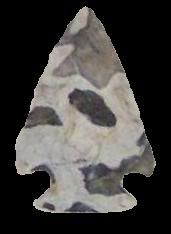
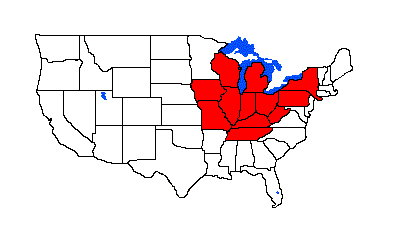
A Thebes point and a map showing the distribution of Thebes points are shown above.
At this same time (7500 BCE), some Indian people were using a stone tool which archaeologists call Hardin points. These points, which were used as both dart points and as knives, have straight or convex sides with straight to expanded stems. The points usually have pronounced barbs. These points are also found in archaeological sites in Ohio, Illinois, Indiana, Wisconsin, Iowa, Missouri, Arkansas, Kentucky, and Tennessee.
Trade has always been important to American Indians. Some of our earliest evidence of trade among the Indian people who lived in Michigan actually comes from a site in Illinois. By 6500 BCE, a group of about 25 Indian people was living at the Koster site. The people at the Koster site were trading to obtain hematite beads from northern Michigan.
While it is common to stereotype ancient Indians as a “stone age” people, this stereotype is not accurate. By 5000 BCE, the Indian people in the Great Lakes area were making tools, weapons, and ornaments from copper. Indians, called the Old Copper Indians by archaeologists, maintained copper mines in the Keweenaw Peninsula and Isle Royale. Here they dug thousands of mining pits. Some of the mining pits were up to 20 feet deep. With hammerstones, birchbark buckets, and a system of levels, the miners extracted the copper from the earth. The metal was then taken back to their villages where it was shaped by cold-hammering and annealing. The tools formed by the Old Copper Indians included leaf-shaped knives and spear-points, fishhooks, harpoon points, gouges, chisels, awls, wedges, punches, needles, drills, and axes.
By 1500 BCE, there is more evidence of long distance trade. At this time, the copper beads manufactured by Michigan Indians had found their way into Poverty Point, a large site in Louisiana.
Burials provide archaeologists with a great deal of information. The bones of the ancestors speak, telling us about their diet, their daily lives, and some of the illnesses which they encountered. They also provide some insights into religious practices. By 1000 BCE, Indian people began burying their dead at the Riverside site. Burial goods suggest that the people had well-developed trade networks with the Ohio River Valley, the Gulf Coast, and the Great Plains. Included in the graves were obsidian from the Yellowstone National Park area of Wyoming, marine shells from the Gulf or Atlantic seacoast, flint from North Dakota, and stone tools from other parts of the Midwest.
Tobacco is important to American Indians, and one of its uses is as a smoking material. By 1000 BCE, Indian people were using tubular-shaped pipes for smoking tobacco. The pipes were flared on the tobacco end and narrowed on the mouth end.
Another common stereotype of American Indians sees them as nomadic hunters and gatherers whose lifestyle was focused on hunting big game animals. Yet, at the beginning of the European invasion, most Indians obtained most of their calories from agricultural crops. One of the important domesticated plants was corn, which had been originally domesticated in Mexico. One of the questions asked by archaeologists is when corn agriculture reached the Great Lakes area.
The first evidence of corn in Michigan is found at the Eidson site: by 240 CE the Indian people at this site had corn. By 600 CE, there is evidence of corn at the Gard Island 2 site, the Indian Island 4 site, the Sissung site, and the Leimbach site. All of these sites are located around western Lake Erie. By 850 CE, Indian people at the Birch Run site had 8-row corn.
While corn certainly marks the beginning of change for many Indian cultures, there was no overnight shift from a hunting and gathering form of subsistence to agriculture. Many groups continued the old ways. In 600 CE, for example, archaeologists report that the economy of Indian people in west-central Michigan was based on hunting, fishing, and gathering with seasonal migrations. Archaeological findings suggest a mixed economic strategy which included fishing in the spring, summer, and fall. In the fall and winter the people hunted deer and other mammals.
One of the largest and most complex Native American civilizations was Mississippian which was centered at Cahokia near present-day St. Louis. By the eleventh century, the Mississippian cultural complex was evident in Michigan. By 1000 CE, Mississippian people were beginning to enter southwestern Michigan.
During the eleventh century there were a number of large village agricultural sites, some of which were indigenous and some of which were influenced by Mississippian culture. These include a large agricultural village on the Kalamazoo River known as the Nordhoff site and Moccasin Bluff. Agriculture at this time included a number of cultigens other than corn, including squash, tobacco, and sunflower.
Permanent villages which are occupied for long periods of time give archaeologists insights into cultural changes. By 1100, the Indian people at the Moccasin Bluff site were using both grit-tempered Moccasin Bluff ware and shell-tempered Berrien ware (pottery). Archaeologists interpret this change in pottery as reflecting an indigenous culture which was heavily influenced by Mississippian. About 1150, there was an increase in population at Moccasin Bluff. There was also a change in the type of pottery being used: shell-tempered, cordmarked pottery decreased while grit-tempered pottery, both cordmarked and plain, increased.
By the thirteenth century, the Indian people in Michigan had economies that included agriculture, hunting, fishing, and gathering wild plants. In 1200, Indian people built a small fortified agricultural village in the upper Muskegon River Valley, known as the Boven earthwork to archaeologists. The people were using cordmarked ceramics. The fortifications found there are an indication of inter-group conflicts.
About 1210, Indian people established a summer fishing and farming village along the Lake Michigan shore north of Grand Traverse Bay. This shows that these people were using agriculture to supplement their subsistence, rather than relying on it exclusively. Instead of permanent villages, they are using summer villages and winter villages, based on available resources.
By 1250 the weather in the lower Great Lakes area was starting to change. The climate was now characterized by decreased rainfall and cooler temperatures. This meant that agriculture became less dependable.
Archaeologists are able to associate some fifteenth century sites with specific tribal affiliations. The ancestors of what appear to be the Fox and Sauk abandon their village at the Fosters site about 1400.
In the fifteenth century, the tribes of the Three Council Fires–the Ojibwa, Ottawa, and Potawatomi- moved south to Lake Huron. The Ottawa stayed at the mouth of the French River and Lake Huron Islands while the Ojibwa and Potawatomi occupied the shoreline to the Mackinac Strait.
A century later, several tribes displaced by the Ojibwa expansion into Michigan and Wisconsin south of the Great Lakes began to migrate. This included the Menominee, who were pushed south and formed an alliance with the Winnebago. The Cheyenne and the Arapaho began to move west. At this time, the Potawatomi began a migration to the Lower Peninsula of Michigan. This set the stage for the Indian nations which the French fur traders would find when they moved into the area in the seventeenth century.
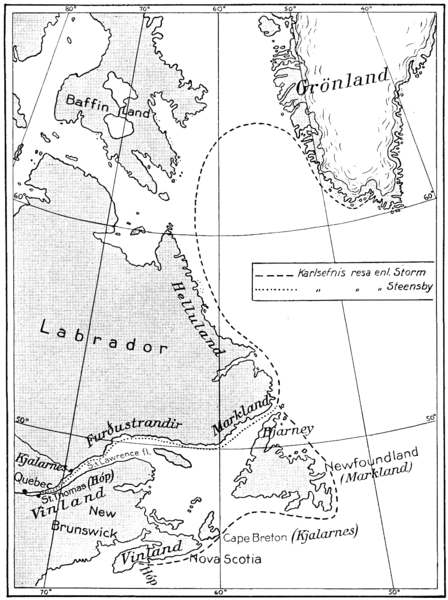
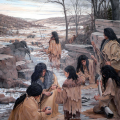
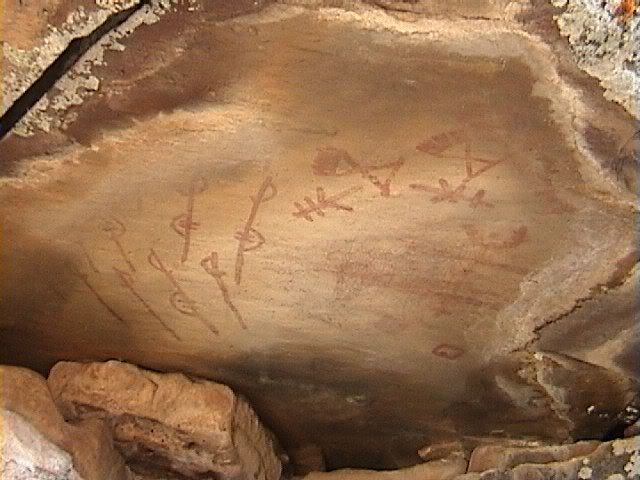

Leave a Reply